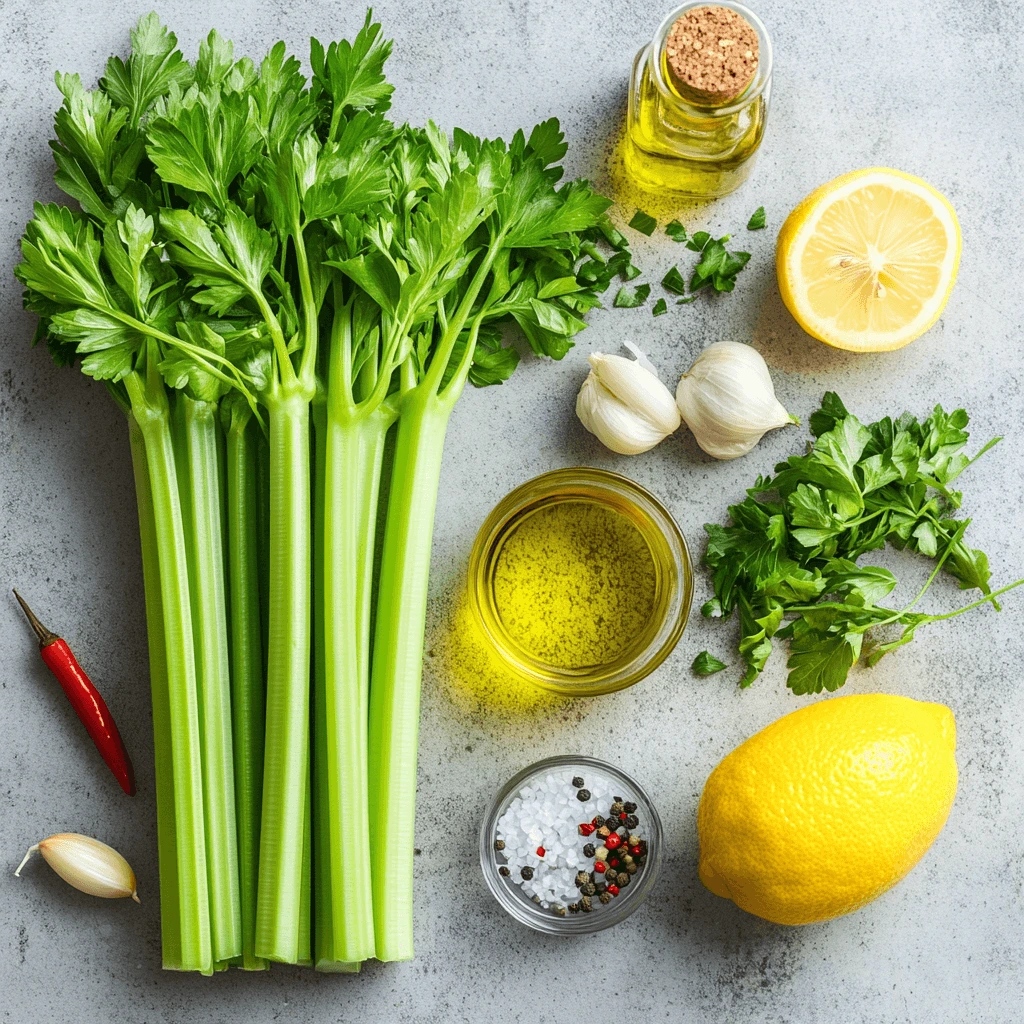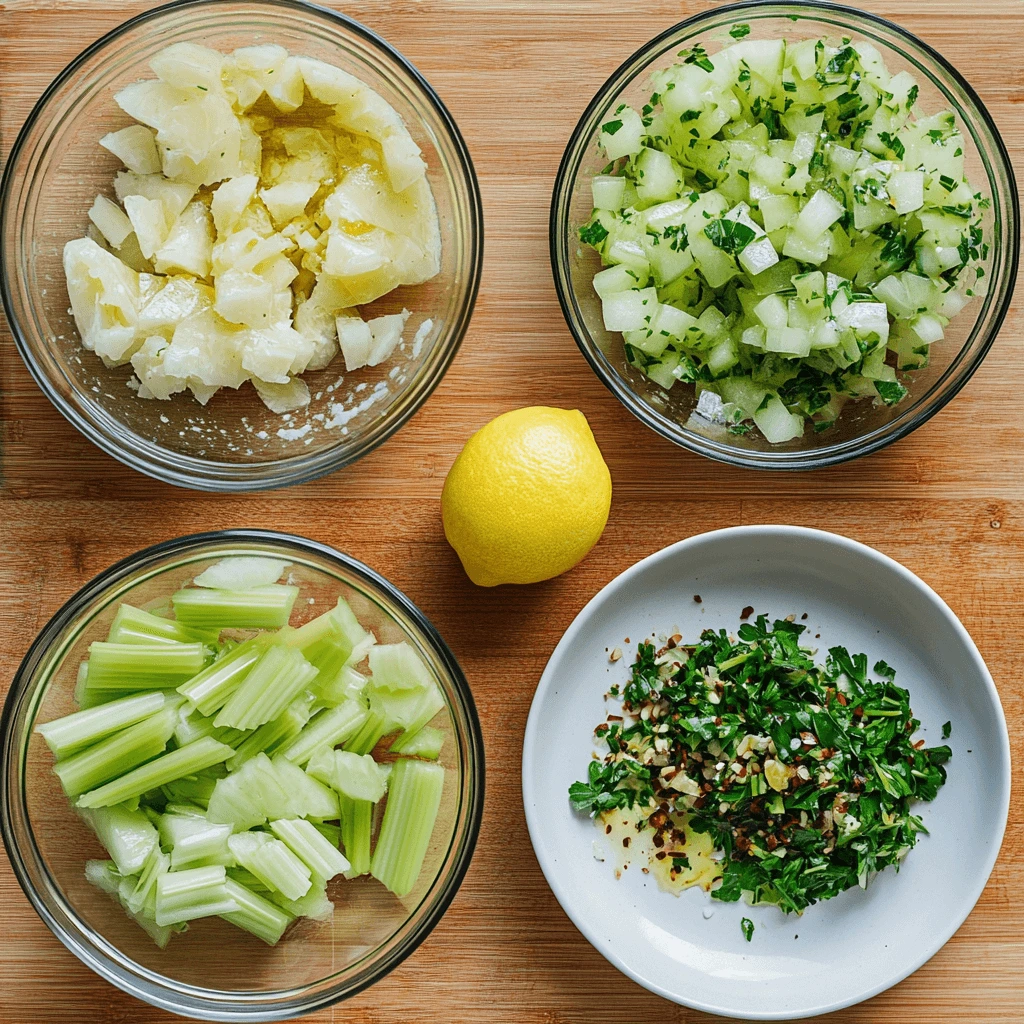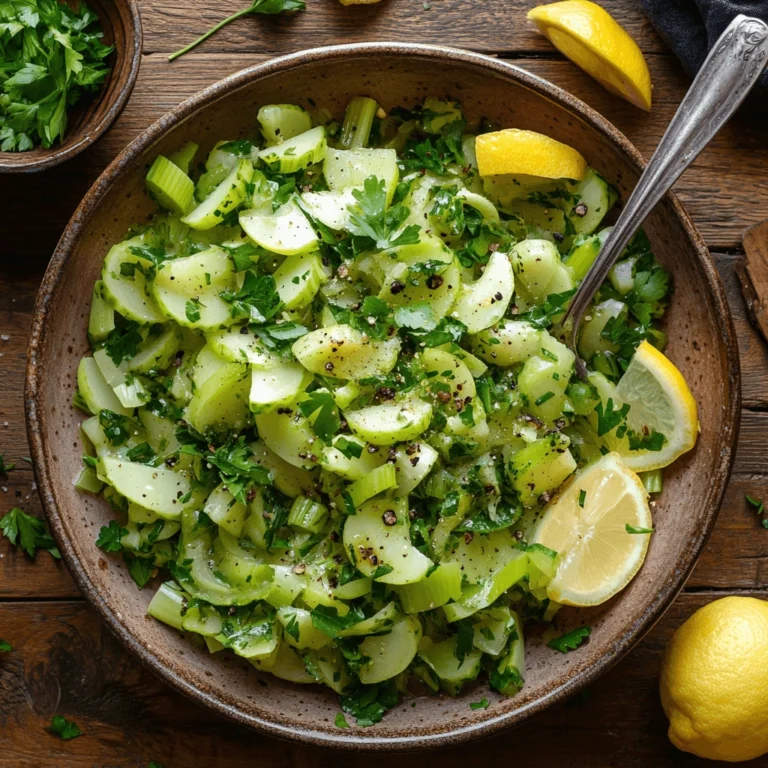Seafood lovers often dream about sun‑soaked Italian coastlines, bustling Sunday markets, and the unmistakable aroma of fresh herbs mingling with briny ocean notes. Scungilli salad captures that day‑dream in one vibrant, refreshing dish. In Southern Italy—and later in Italian‑American kitchens—this marinated sea‑snail salad became a staple at Christmas Eve’s Feast of the Seven Fishes, yet it is equally cherished at summer picnics and casual family lunches. Today, we will journey through its origin, choose the finest ingredients, and master each step so you can serve the best Scungilli salad at home.
What Is Scungilli Salad? A Mediterranean Seafood Classic
The Meaning and Origin of Scungilli
- Scungilli is the Neapolitan dialect word for edible sea snails, most commonly the Atlantic conch (Busycon canaliculatum).
- Historically, coastal communities gathered these mollusks while fishing for larger catches. Because nothing went to waste, families simmered the snails until tender, sliced them thinly, and tossed them with garden vegetables.
- Over time, Italian immigrants in New York and New Jersey adapted the recipe. Nevertheless, they preserved its key traits: citrusy freshness, peppery heat, and a light olive‑oil sheen.
Consequently, Scungilli salad became a culinary bridge between Old World and New. Moreover, its lean protein profile fit perfectly into the heart‑healthy Mediterranean diet, which further boosted its popularity.
Scungilli vs. Conch – What’s the Difference?
- Terminology
- Scungilli = sea snail meat in Italian‑American contexts.
- Conch = the English term for similar large marine snails.
- Texture & Flavor
- Both offer a firm, slightly chewy bite; however, Atlantic conch tends to be milder than Caribbean queen conch.
- Usage
- Italians marinate scungilli in lemon and herbs.
- Caribbean cooks prefer spicy conch fritters or ceviche.
Therefore, if your fishmonger labels the meat as conch, you can still prepare a traditional Scungilli salad. Just slice it thinly so the dressing permeates every bite.
A Staple in the Feast of the Seven Fishes
During La Vigilia (Christmas Eve), Italian Catholics refrain from meat and instead celebrate with seven seafood dishes. Scungilli salad frequently appears alongside calamari, baccalà, and shrimp because:
- It can be prepared a day ahead, freeing the cook for last‑minute dishes.
- Its bright acidity balances richer plates like fried smelts.
- Guests appreciate a chilled starter before warm entrées arrive.
Furthermore, many families believe serving an odd number of fish dishes—seven, nine, or thirteen—brings good fortune in the new year. Thus, Scungilli salad not only satisfies hunger but also carries cultural symbolism.
Traditionally served during La Vigilia, or Christmas Eve, scungilli salad plays a key role in Southern Italian holiday meals. Learn more about the origins of the Feast of the Seven Fishes and how seafood dishes became central to this cherished culinary celebration.
If you’re building a full Italian menu, try our indulgent Burrata Ravioli Recipe alongside your scungilli salad for a perfect seafood-pasta pairing.
Ingredients You Need for the Best Scungilli Salad

Core Ingredients – Scungilli, Lemon, and Olive Oil
- Scungilli (1 kg / 2.2 lb cooked weight)
- Fresh lemon juice (60 ml / ¼ cup)
- Extra‑virgin olive oil (80 ml / ⅓ cup)
These three components create the backbone of flavor. Because lemon cuts through any briny notes and olive oil provides silky richness, the dish remains light yet satisfying.
Fresh Herbs and Vegetables That Add Crunch and Aroma
- Celery ribs, thinly sliced (3)
- Flat‑leaf parsley, finely chopped (½ cup)
- Garlic cloves, minced (2)
- Red chili flakes (½ tsp, adjust to taste)
- Sea salt and cracked black pepper (to taste)
Moreover, the crisp celery contrasts the chewy seafood, while parsley and garlic layer in unmistakable Mediterranean fragrance. In addition, chili flakes lend gentle warmth without overpowering delicate flavors.
Optional Add‑Ins and Modern Twists
- Roasted red‑pepper strips for smoky sweetness.
- Capers to intensify briny complexity.
- Kalamata olives when you crave a salty pop.
- Diced cucumber for extra crunch during hot weather.
Because these additions respect the original profile, they keep your Scungilli salad authentic yet personalized.
How to Prepare Scungilli for Salad
Where to Find or Buy Scungilli
- Canned scungilli: Convenient, already cooked, and shelf‑stable. Look for products packed in water, not brine, to avoid excess salt.
- Frozen conch steaks: Available at international seafood counters. Thaw slowly in the refrigerator.
- Fresh whole conch: Rare but luxurious; ask your fishmonger to remove the shell if possible.
Furthermore, check Italian‑American grocery stores around Christmas, as demand peaks then.
Cleaning and Cooking Scungilli Properly
- Rinse the meat under cold running water to remove sand.
- Trim any dark operculum (the “foot”) because it stays tough.
- Tenderize
- Fresh: Simmer in lightly salted water for 45–60 minutes until a knife slides through easily.
- Frozen steaks: Pressure‑cook for 15 minutes on high, quick‑release, and cool.
- Canned: Already cooked, so skip boiling.
Consequently, you guarantee a tender bite rather than rubbery chewiness.
Pro Tips for Marination and Flavor Absorption
- Slice scungilli into 3 mm (⅛‑inch) rings; thinner slices absorb dressing faster.
- Marinate for at least 4 hours—overnight is ideal.
- Always chill in a glass or stainless‑steel bowl; plastic can hold odors.
- Stir halfway through marination so every piece bathes in lemony goodness.
Because the acid continues to tenderize the seafood, the flavors deepen while you sleep—resulting in a show‑stopping Scungilli salad the next day.
Step-by-Step Scungilli Salad Recipe

Ingredients List (Serves 6)
- 1 kg cooked scungilli, sliced
- 3 celery ribs, thinly sliced on the bias
- ½ cup chopped flat‑leaf parsley
- 2 garlic cloves, minced
- 60 ml fresh lemon juice
- 80 ml extra‑virgin olive oil
- ½ tsp red chili flakes
- Sea salt and cracked black pepper, to taste
- Optional: ½ cup roasted red‑pepper strips, 2 Tbsp capers, ¼ cup pitted Kalamata olives
Instructions
1 – Prepare the Dressing
- Whisk lemon juice, olive oil, garlic, chili flakes, salt, and pepper in a small bowl.
- Taste and adjust acidity; add more lemon if you prefer sharper notes.
2 – Combine and Marinate
- Place sliced scungilli, celery, and parsley in a large mixing bowl.
- Pour the dressing over the seafood mixture.
- Fold gently until every piece glistens.
- Cover with compostable wrap; refrigerate for 4–24 hours.
3 – Add Optional Ingredients
- After 2 hours of marination, stir in roasted peppers, capers, or olives if using. Because these items are already salty, taste before adding extra seasoning.
4 – Serve
- Transfer the salad to a shallow platter.
- Garnish with additional parsley leaves and a final squeeze of lemon.
- Offer crusty bread on the side so guests can mop up the citrusy dressing.
Suggested Serving Ideas
- Antipasto Platter: Pair with marinated artichokes, grilled zucchini, and a wedge of aged provolone.
- Seafood Sunday Lunch: Serve alongside chilled octopus salad and a crisp green‑leaf salad.
- Summer BBQ: Because it stays cool, Scungilli salad complements smoky grilled vegetables and herb‑rubbed chicken.
Moreover, the dish travels well in a cooler, making it perfect for beach picnics.
Love seafood appetizers? Don’t miss our elegant and flavorful Crab Brulee Recipe: How to Make the Perfect Appetizer for your next gathering.
Frequently Asked Questions About Scungilli Salad
Can I Make Scungilli Salad Ahead of Time?
Yes, and you should! Prepare the salad the night before serving. Consequently, flavors meld, and the celery retains pleasant crunch. Store in an airtight container for up to 48 hours. Beyond that point, texture declines.
What’s the Best Substitute for Scungilli?
If scungilli is unavailable, choose calamari rings or blanched octopus slices. They share similar firmness and soak up dressing well. Alternatively, use steamed shrimp, though the flavor profile will shift slightly.
Is Scungilli Salad Healthy?
Absolutely. Per 100 g, scungilli provides:
- 24 g protein
- <1 g fat (before dressing)
- Rich in vitamin B12 and magnesium
Because the recipe uses olive oil and no mayonnaise, it fits Mediterranean‑diet guidelines. Furthermore, it is dairy‑free, gluten‑free, and pork‑free, satisfying diverse dietary needs.
Conclusion
From its humble Neapolitan roots to its proud place on Italian‑American holiday tables, Scungilli salad proves that simple ingredients can create unforgettable flavor. You now know where to source quality scungilli, how to cook it tender, and which herbs elevate each bite. Therefore, gather your ingredients, whisk that lemony dressing, and let tradition unfold in your kitchen. After one forkful, you—and your guests—will taste the sun‑kissed shores of Southern Italy, no plane ticket required. Buon appetito!


1 thought on “How to Make the Best Scungilli Salad: Authentic Italian Recipe”